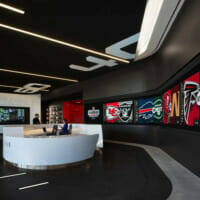BLOG
Leading Conference Room Technology for 2022
Simple. Audio. Visual.
Over the last two years, conference room technology has morphed out of necessity to keep communications and productivity flowing. Now, as associates return to the office, companies that had to suddenly transition the conference room experience remote are now modifying the in-office collaboration experience to mimic the intuitive and intimate experience users enjoyed while working from home.
Simple Operation
Associates are returning to the office a changed workforce, bringing a new set of expectations with them. If connecting to a meeting at home is as simple as the click of a button on a laptop, then there is no reason for conference room technology to deliver anything less.
With many having worked from home for so long, companies are looking to capture the simplicity of the home environment that they have become accustomed to—leading to a dramatic rise in the adoption of collaboration platforms. To keep a remote workforce engaged, these organizations need platforms that scale–like Microsoft Teams–for not only a smoother return to in-office conference and huddle spaces but also an elevated hybrid experience in today’s digital workplace.
Certified for Microsoft Teams, Zoom and BYOD, Crestron consoles quickly turn your tabletop into an intuitive collaboration hub. Similarly, HP offers additional complementary products to enhance the Microsoft Teams collaboration experience. With the proper design, touch panels behave the same as today’s leading platforms for consistency and ease-of-use.
Clear Audio
Though it may seem like a distant memory, we’ve all endured those meetings where we were more focused on distracting background noises instead of on the content being presented. However, improved audio tools are realigning our focus, not only delivering better sound for the remote participants but also creating a more immersive conversation for those in the conference room.
Advanced sound bar technology from Crestron and Poly focus on speaking voices to ensure that the message is delivered with optimal clarity. The same is true for the audio being collected for remote participants. Microphones have gotten smarter and, when configured in an array, are able to focus on the various speakers in the room, delivering a clear speech reproduction on the other end.
Engaging Video
Video capability is no longer a luxury for collaboration but a requirement. While working from home, we’ve become accustomed to having digital face-to-face conversations with ease. Using just a laptop or single camera, collaboration platforms create an intimate virtual environment for enhanced communication. So why go back to a conference room camera that shows a static or partially empty meeting room?
The ability to auto-frame is critical to keeping remote participants engaged in the conversation. Today’s cameras from leading brands like Vaddio from Legrand AV have the intelligence to jump between speakers to better highlight the person talking and deliver a more intimate collaboration experience for remote participants.
For presentation sharing, it’s important to consider room size and viewing distance when selecting displays from leading manufacturers like Barco. Complementary products like advanced mount solutions from Legrand AV’s Chief pair together to deliver the visual engagement you need along with the clean and sophisticated aesthetic you want.
Easy Scheduling
Although most of the collaboration user experience happens within the conference room itself, it often starts with the room scheduling. Much like the Crestron touch panels used to kick-start a meeting inside, adding Crestron scheduling panels immediately outside the room help complete the overall ecosystem of the space. Not only does it let associates easily see which rooms are available but also who already has them booked. Combined with the user-friendly technology in the room, these solutions are empowering user confidence to self-manage all aspects of their collaboration—from scheduling to starting to wrapping things up.
Continuing Trends and Impacts
While it’s no secret that conference room technology was already going in this direction, the pandemic and return to work has certainly accelerated these changes due to the stark contrast of the remote and conference room experience. However, these modifications that were originally intended to mimic the simplified experience that users enjoyed while collaborating from home are providing additional benefits.
For example, smart cameras are now able to track the number of people in a conference room as well as how long the room is in use, which are both useful for facilities planning. Additionally, intelligence that is built into the newer systems not only provides metrics for facilities but also enables enhanced remote support and monitoring for maximum uptime.
Overall, the goal of these conference room technology solutions is to provide a better collaboration experience for users and improve the ability to communicate mission critical information. Employers want their associates to come back to the office, but that means making the necessary adjustments to meet new expectations of a changed workforce.








